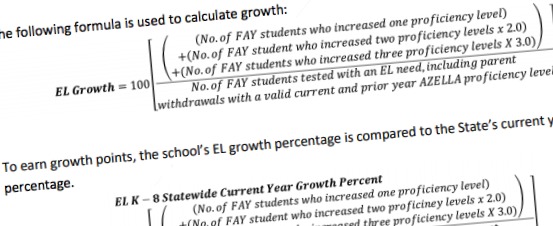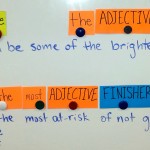Warning: Grumpy face.
You’ve run the race, and you need to start strategizing how you will train for the next one. But you won’t know the results of the race for months.
Innovation can be exhilarating… as well as exhausting, and challenging given our current levels of funding (and therefore staffing, training and other resources). I think I have already written about that to some degree this year.
Innovation with the added pressure of being an “F” school in the state of Arizona is exhilarating, exhausting, challenging… and a game we play almost blind.
Last week our school received our AZELLA scores. There is a lot riding on these scores this year, because ten percent of our school letter grade is based on English Learner proficiency and growth. Needless to say, I was anxious and curious as we awaited the scores, and dug into my binder of reports as soon as our SEI tech was able to print them out and hole punch them.
Of course, the first thing I wanted to know was which students passed. The list was not long enough to thrill me, although I was thrilled for those individual students.
Then we had to look at how many students went up one, two or three levels. (The levels defined by the state are pre-emergent/emergent, basic, intermediate and proficient.) Keep in mind that moving up three levels would mean moving from pre-emergent/emergent all the way up to proficient within one calendar year. It is possible, and I have had one student who did it (once, in four years.)
Looking over which students had moved up levels was both gratifying and frustrating, from line to line on the spreadsheet. For every number, there was a story. Someone who had been out of school for four years as her family migrated from Honduras; someone who loved art, science and KPop and would learn quickly even if no grades were awarded; a handful who were suspended for drug violations leading up to the testing week; someone who was quiet and reserved, but diligent; someone who is probably dyslexic but we can’t sort that out from his language acquisition needs yet; someone who has an iPad and a cell phone but says that Canvas confuses him; someone who is homeless; someone with anxiety; someone whose social nature is both a challenge in the classroom, and an asset in learning English; someone with an IEP. The stories go on.
I wanted to present my principal with a summary of the information that the state uses to determine how many points of those ten we will earn for our English learners this year. I wanted the summary to show we had improved, that we had leveraged the flexible schedules, social emotional learning and team support that our innovative structures offered this year while avoiding the pitfalls of creating brand new systems from the ground up.
Even after researching all the state letter grade formulas, I couldn’t provide coherent information to my principal. Our numbers of English learner students grew a lot from last year, and there are complex factors used to “transform” the numbers that a non-statistician like me who does not have the state level data (or even complete school-level data yet) could not hope to calculate or even estimate (see pages 33-37 of this document).
All I knew looking at the numbers was that proportionally, compared to last year, things in the ELD department didn’t look fantastic at first glance. Which, despite several personal victories for individual students, was depressing (because remember when I said innovation was exhausting and challenging, though exhilarating? I am on the exhausted end of the year).
But what do I know? And I literally mean, what do I know? I honestly can’t figure the numbers out. I am at the mercy of the people whose job it is to crunch the numbers, and I do not like this feeling. We are already planning our program for next year, with new standards and new placement requirements. Standardized tests aren’t everything, but in terms of school letter grades and, quite literally, the future of our learning community, understanding the results is crucial to be able to plan effectively. Who knows? Maybe we did all right.
I am guessing all these transformations of data are meant to make our school letter grade more fair, but if it makes us feel more helpless in evaluating our own progress, then doesn’t that defeat the purpose of the giving schools a letter grade? Unless, of course, the grade is simply a punishment.










Comments 5
I really appreciate reading your take on AZELLA scores. Interesting!
I know you have been anxiously awaiting these scores. I gave the AZELLA many years ago as a baby ELL teacher. But you are right, what did it tell me about my kids? What I really needed to know was how they were doing in school. How were they accessing the curriculum, all in Enlgish, when they had varying levels of language mastery? In my years of teaching ELL and BLE, I saw kids make monumental gains that I have never again seen in a general ed classroom. To measure what they learned by a test certainly seems like it is punitive.
Yes– the test is always problematic. There are so many other sources of data about our students that are just as or more important! It’s frustrating to have my focus be so much on the school letter grade, but it’s a must.
I appreciate your perspective on this .. thanks for sharing .. one of these days I’d love to chat you up on what you guys do with these scores ..
I would love to chat. We do a lot with these scores, but I can’t figure out what to do w/ them in terms of a school letter grade, that’s for sure!